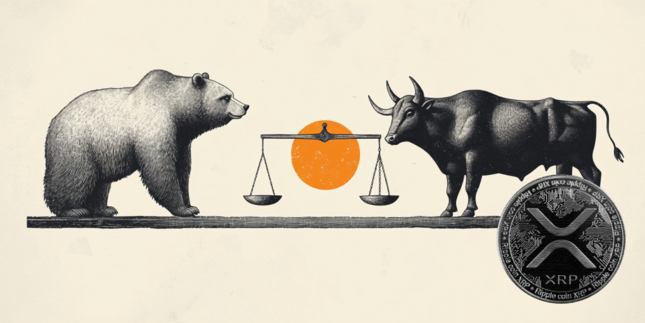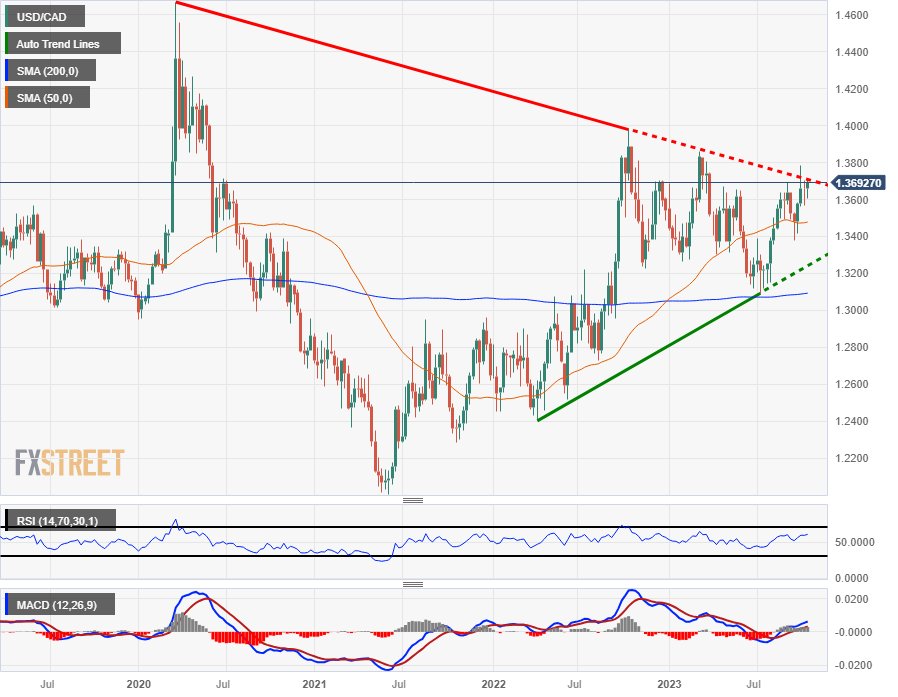- The Canadian Dollar is falling back into familiar lows on Wednesday as investors pull up stakes.
- Canada Housing Starts came in better than expected, but risk-off flows are dominating.
- Thin calendar docket for the CAD until Friday’s Retail Sales.
The Canadian Dollar (CAD) is falling back in the American market session as risk appetite takes a turn south, sending investors back into the US Dollar (USD) and taking the USD/CAD back up the charts.
Canada Housing Starts managed to eke out a better-than-expected print, with US housing data coming in mixed, but overall market sentiment has turned risk-off mid-week, and the US Dollar is rising across the board, sending the Loonie lower in lockstep with Crude Oil prices that are declining back into the day’s opening bids.
Daily Digest Market Movers: Canadian Dollar reverses course at the midway point as risk appetite turns tail
- Canadian Housing Starts beat expectations, showing 270.5 thousand additional homes begin constructed over the year into September.
- The data easily cleared the forecast 240K, and stepped over the last reading of 250.4K (revised downwards from 253K).
- US housing data landed with mixed results, with Building Permits beating expectations but Housing Starts flubbing the forecast.
- The US issued 1.475M new building permits in September, just above the 1.45M forecast but less than August’s 1.541M (revised down from 1.543M).
- US Housing Starts disappointed markets, with 1.358M houses or apartment units beginning construction in September, less than the expected 1.38M, but still an improvement over August’s 1.269M (revised down from 1.283M).
- Thursday still sees US Initial Jobless Claims, as well as a slew of speeches from Federal Reserve (Fed) officials, including Fed Chair Jerome Powell at 16:00 GMT tomorrow.
- Crude Oil saw bidding during the early Wednesday trading session, but the American market window is seeing investors hesitate, and Oil prices are falling back to where they started.
- Global geopolitical tensions over the Israel-Hamas conflict continue to weigh on investor risk appetite.
- The US is also suffering from its own homegrown political uncertainty as the US Government struggles to replace its House Speaker who was ejected by his own party.
- US Treasury yields have hit yet another high, with the US 10-year yield at its highest yield in seventeen years near 4.92%.
Technical Analysis: Canadian Dollar falls back as traders pile back into the Greenback
USD/CAD tried to break past the 1.3700 handle on Wednesday, testing into swing high prices that have become familiar territory in recent weeks. The pair has been in a massive range for a whole year, oscillating between highs just short of 1.4000 and lows in the 1.31s. It is once again approaching the range highs.
In fact the pair is wrestling with a major trendline at around 1.3685, drawn by connecting the October 2022 and March 2023 highs, and this is likely to present tough overhead resistance. Ideally a decisive break is required to definitively put this ceiling in the rear-view mirror.
Such a break would be characterized by a longer-than-average green weekly candle breaking cleanly through the resistance line, or three successive green weekly bars.
Despite the sideways primary trend, the intermediate and short-term trends are more bullish suggesting longs have their backs to the wind. This lends a bias to more upside, and if it were not for the major resistance line there would be a green light signaling ‘go’ – as it is it could prove a spoiler.
USD/CAD Weekly Chart
Canadian Dollar FAQs
What key factors drive the Canadian Dollar?
The key factors driving the Canadian Dollar (CAD) are the level of interest rates set by the Bank of Canada (BoC), the price of Oil, Canada’s largest export, the health of its economy, inflation and the Trade Balance, which is the difference between the value of Canada’s exports versus its imports. Other factors include market sentiment – whether investors are taking on more risky assets (risk-on) or seeking safe-havens (risk-off) – with risk-on being CAD-positive. As its largest trading partner, the health of the US economy is also a key factor influencing the Canadian Dollar.
How do the decisions of the Bank of Canada impact the Canadian Dollar?
The Bank of Canada (BoC) has a significant influence on the Canadian Dollar by setting the level of interest rates that banks can lend to one another. This influences the level of interest rates for everyone. The main goal of the BoC is to maintain inflation at 1-3% by adjusting interest rates up or down. Relatively higher interest rates tend to be positive for the CAD. The Bank of Canada can also use quantitative easing and tightening to influence credit conditions, with the former CAD-negative and the latter CAD-positive.
How does the price of Oil impact the Canadian Dollar?
The price of Oil is a key factor impacting the value of the Canadian Dollar. Petroleum is Canada’s biggest export, so Oil price tends to have an immediate impact on the CAD value. Generally, if Oil price rises CAD also goes up, as aggregate demand for the currency increases. The opposite is the case if the price of Oil falls. Higher Oil prices also tend to result in a greater likelihood of a positive Trade Balance, which is also supportive of the CAD.
How does inflation data impact the value of the Canadian Dollar?
While inflation had always traditionally been thought of as a negative factor for a currency since it lowers the value of money, the opposite has actually been the case in modern times with the relaxation of cross-border capital controls. Higher inflation tends to lead central banks to put up interest rates which attracts more capital inflows from global investors seeking a lucrative place to keep their money. This increases demand for the local currency, which in Canada’s case is the Canadian Dollar.
How does economic data influence the value of the Canadian Dollar?
Macroeconomic data releases gauge the health of the economy and can have an impact on the Canadian Dollar. Indicators such as GDP, Manufacturing and Services PMIs, employment, and consumer sentiment surveys can all influence the direction of the CAD. A strong economy is good for the Canadian Dollar. Not only does it attract more foreign investment but it may encourage the Bank of Canada to put up interest rates, leading to a stronger currency. If economic data is weak, however, the CAD is likely to fall.
Information on these pages contains forward-looking statements that involve risks and uncertainties. Markets and instruments profiled on this page are for informational purposes only and should not in any way come across as a recommendation to buy or sell in these assets. You should do your own thorough research before making any investment decisions. FXStreet does not in any way guarantee that this information is free from mistakes, errors, or material misstatements. It also does not guarantee that this information is of a timely nature. Investing in Open Markets involves a great deal of risk, including the loss of all or a portion of your investment, as well as emotional distress. All risks, losses and costs associated with investing, including total loss of principal, are your responsibility. The views and opinions expressed in this article are those of the authors and do not necessarily reflect the official policy or position of FXStreet nor its advertisers. The author will not be held responsible for information that is found at the end of links posted on this page.
If not otherwise explicitly mentioned in the body of the article, at the time of writing, the author has no position in any stock mentioned in this article and no business relationship with any company mentioned. The author has not received compensation for writing this article, other than from FXStreet.
FXStreet and the author do not provide personalized recommendations. The author makes no representations as to the accuracy, completeness, or suitability of this information. FXStreet and the author will not be liable for any errors, omissions or any losses, injuries or damages arising from this information and its display or use. Errors and omissions excepted.
The author and FXStreet are not registered investment advisors and nothing in this article is intended to be investment advice.
Recommended content
Editors’ Picks

EUR/USD recovers above 1.0950 on US Dollar weakness
EUR/USD is recovering further ground above 1.0850 in early Europe on Tuesday amid a broadly weaker US Dollar. The recovery in risk sentiment undermines the havem demand for the US Dollar, lifting the pair. Dovish Fed expectations also weigh negatively on the Greenback. Tariff updates eyed.

GBP/USD: Upside remains capped below 1.2800
GBP/USD is consolidating its rebound to near 1.2800 in Tuesday's European morning. The pair draws support from renewed US Dollar weakness and a positive shift in risk sentiment but US President Trump's tariff war and global growth concerns limit its upside.

Gold price moves away from multi-week low set on Monday; climbs to $3,000 mark
Gold price attracts some dip-buyers as worries over US tariffs revive safe-haven demand. Bets for more aggressive Fed rate cuts weigh on the USD and also benefit the commodity. A slight recovery in the global risk sentiment might cap further gains for the XAU/USD pair.

XRP battles tariff turbulence amid MVRV buy signal
Ripple seeks stability in a volatile crypto landscape influenced by macroeconomic factors, including reciprocal tariffs. The international money transfer token hit a low of $1.64 on Monday after opening the week at $1.92, representing a 14.5% daily drop.

Strategic implications of “Liberation Day”
Liberation Day in the United States came with extremely protectionist and inward-looking tariff policy aimed at just about all U.S. trading partners. In this report, we outline some of the more strategic implications of Liberation Day and developments we will be paying close attention to going forward.

The Best brokers to trade EUR/USD
SPONSORED Discover the top brokers for trading EUR/USD in 2025. Our list features brokers with competitive spreads, fast execution, and powerful platforms. Whether you're a beginner or an expert, find the right partner to navigate the dynamic Forex market.




